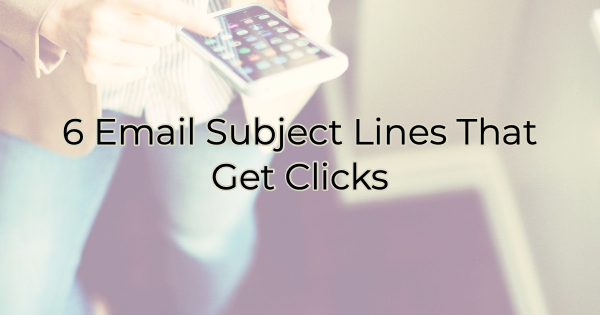6 Email Subject Lines That Get Clicks
Your email content can be the best thing out there, but if people don’t open your emails, the emails might as well be blank.
Two things make recipients click: who it’s from and how appealing the subject line is. In that order. That’s one reason it’s smart to send emails from a person (or at least an email that resembles one), not “no-reply@biz.
But how do you create better subject lines; the kind that are irresistible? How do you inspire clicks and drive recipients to open your emails?
Try these types of emails.

6 Types of the Most Clickable Emails
Think of your own inbox and how many emails you receive during the day. Most of us are on fast delete or swipe when we’re clearing out emails. You need to grab the recipient’s attention quickly. Here’s how:
Solve a Problem
What does your product or service help people do? Or what is this email designed to do for them? What value do they get from opening and reading it? Be specific and brief.
Example: Get more sleep with <Comfy Blanket> or
Say good-bye to restless nights with this easy solution
Or solve a problem they haven’t considered yet.
Example: Get mom’s gift yet? Mother’s Day is next Sunday.
Add the Color
While simple vocabulary is important in a subject line, that doesn’t mean you give up on painting a tantalizing picture. Use evocative imagery and appeal to their senses. Don’t hesitate throwing in an emoji or two (unless your subject or business is incredibly serious).
Example: Warm cinnamon apple pie is calling 🥧
Invite Curiosity
We’re naturally curious and when you factor in the fear of missing out, it can be a powerful motivator of clicks. If you’ve had a recent event or launch, you can use that to your advantage.
Example: Be the first to see our new spring line
See what our opening day participants did
Explain the Send
If your audience is similar to most people, they often sign up for things and forget them. In their defense, a lot of businesses sell contact info and then the new businesses claim you signed up for the list. While that may be true, the list you signed up for initially was not their list.
To differentiate yourself from these businesses, be specific when the information was (actually) requested by the recipient.
Example: Your requested newsletter from <business> or
The <download> you requested from <business>
Detail Benefits
People want to know why they should click. Tell them. If there’s a deadline, communicate that too.
Example: Today’s top deals under $100 or
Unlock access to free delivery or
How to get a FREE <product or service>
Give Them Something They Dream About
Everyone wants something but they may not feel like they can or should. They may view your product or service as a splurge or something they need to put off. Give them a reason to feel otherwise.
Example: Treat yourself to a luscious cake or
Reward your hard work with a new look
Cover the COVID grays with our newest treatment
Finally, if you want better subject lines keep them under 41 characters (not words) as often as possible and consider how they will look on a phone. Figure out what words will be cut off. Sometimes the cut can make your message more evocative and interesting. Other times, it can look sordid or mean something you didn’t intend. Keep the message short and get right to the benefit. After all, that’s what people are most interested in.
Want to do more for your business messaging or get more people interested in your business? Then it may be time to work on your brand.
Don’t miss our Help from the Brand Doctor webinar on May 5th at noon.
